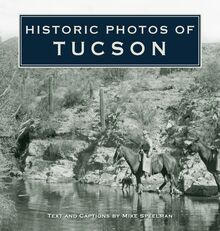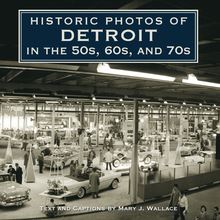Historic Photos of Florida Tourist Attractions , livre ebook
210
pages
English
Ebooks
2008
Vous pourrez modifier la taille du texte de cet ouvrage
Obtenez un accès à la bibliothèque pour le consulter en ligne En savoir plus
Découvre YouScribe en t'inscrivant gratuitement
Découvre YouScribe en t'inscrivant gratuitement
210
pages
English
Ebooks
2008
Vous pourrez modifier la taille du texte de cet ouvrage
Obtenez un accès à la bibliothèque pour le consulter en ligne En savoir plus
Publié par
Date de parution
01 janvier 2008
Nombre de lectures
2
EAN13
9781618586261
Langue
English
Poids de l'ouvrage
38 Mo
Today, we're familiar with the major theme parks which charge families hundreds of dollars a day to wait in line for moments of thrills on technologically amazing rides. Florida, however, has been drawing tourists for centuries with simpler attractions which cost much less to view the animals or exhibits, or commune with nature. In Historic Photos of Florida Early Tourist Attractions, Steve Rajtar brings us back to the simpler ways early visitors enjoyed their time in the Sunshine State.
Tour the state with photos of the tourist attractions which were here before Walt Disney World, in the days when a row of antique cars sufficed and tourists did not require constant action. See the wax figures which amazed visitors long before the invention of audioanimatronic mannequins. See what curiosities brought in the tourists and their dollars decades before today's theme parks dominated the billboards and themselves became worldwide vacation destinations.
Publié par
Date de parution
01 janvier 2008
Nombre de lectures
2
EAN13
9781618586261
Langue
English
Poids de l'ouvrage
38 Mo
HISTORIC PHOTOS OF
FLORIDA TOURIST
ATTRACTIONS
T EXT AND C APTIONS BY S TEVE R AJTAR
Henry Plant built the Tampa Bay Hotel to attract railroad passengers. It opened in 1891 at a cost of $3 million, featuring a Moorish Revival style modeled after the Alhambra Palace in Granada, Spain. There are twelve towers with bulbous domes and cupolas, ornate porches, and covered cornices. The former resort now houses the University of Tampa.
HISTORIC PHOTOS OF
FLORIDA TOURIST
ATTRACTIONS
Turner Publishing Company
200 4th Avenue North Suite 950
Nashville, Tennessee 37219
(615) 255-2665
412 Broadway P.O. Box 3101
Paducah, Kentucky 42002-3101
(270) 443-0121
www.turnerpublishing.com
Historic Photos of Florida Tourist Attractions
Copyright 2008 Turner Publishing Company
All rights reserved.
This book or any part thereof may not be reproduced or transmitted in any form or by any means, electronic or mechanical, including photocopying, recording, or by any information storage and retrieval system, without permission in writing from the publisher.
Library of Congress Control Number: 2007936866
ISBN-13: 978-1-59652-417-0
Printed in the United States of America
08 09 10 11 12 13 14 15-0 9 8 7 6 5 4 3 2 1
C ONTENTS
A CKNOWLEDGMENTS
I NTRODUCTION
ALACHUA COUNTY
BAY COUNTY
BREVARD COUNTY
BROWARD COUNTY
CITRUS COUNTY
CLAY COUNTY
COLLIER COUNTY
DUVAL COUNTY
ESCAMBIA COUNTY
FRANKLIN COUNTY
GLADES COUNTY
GULF COUNTY
HAMILTON COUNTY
HERNANDO COUNTY
HILLSBOROUGH COUNTY
INDIAN RIVER COUNTY
JACKSON COUNTY
LAKE COUNTY
LEE COUNTY
LEON COUNTY
LEVY COUNTY
LIBERTY COUNTY
MANATEE COUNTY
MARION COUNTY
MARTIN COUNTY
MIAMI-DADE COUNTY
MONROE COUNTY
NASSAU COUNTY
OKALOOSA COUNTY
ORANGE COUNTY
OSCEOLA COUNTY
PALM BEACH COUNTY
PINELLAS COUNTY
POLK COUNTY
PUTNAM COUNTY
ST. JOHNS COUNTY
SARASOTA COUNTY
SEMINOLE COUNTY
SUMTER COUNTY
TAYLOR COUNTY
VOLUSIA COUNTY
WAKULLA COUNTY
WALTON COUNTY
N OTES
B IBLIOGRAPHY
In 1955, the Gulfarium opened in Fort Walton Beach with a porpoise theme. Porpoises performed in the large pool. Porpoises were shown on posters and signs throughout the park. The sign along the road showed a porpoise outlined in neon, constantly jumping through a hoop. The attraction is still entertaining porpoise fans today.
A CKNOWLEDGMENTS
This volume, Historic Photos of Florida Tourist Attractions , is the result of the cooperation and efforts of many individuals and organizations. It is with great thanks that we acknowledge the valuable contribution of the Library of Congress, the State Archives of Florida, and the many photographers and collectors who have shared their images of the state by donating them to the Florida Photographic Collection.
We would also like to thank the hundreds of millions of tourists who have visited Florida since the state was new, anxious to pay for the opportunity to be entertained and amazed. Without their curiosity, most of the attractions depicted in this book would not have existed.
I NTRODUCTION
Since the earliest days following its discovery by Europeans in the 1500s, Florida has been attracting visitors who seek adventure, wealth, escape from civilization, and opportunities to set up their own businesses to attract the dollars of others. Early tourist attractions were comparatively simple, some consisting merely of natural phenomena such as spouting artesian wells, clear spring waters, large or unusual trees, or a variety of ways to view and enjoy the flora, fauna, water, and sunshine.
Many of the early attractions were little more than small exhibits of curious objects or animals. A structure of coral or a collection of parts of trees might bring in visitors willing to pay a nominal amount, just enough to keep the attraction in existence.
The late 1800s also ushered in an era of elaborate hotels, themselves intended to be tourist destinations. Resorts with golf courses, water sports, and gourmet food became popular, especially with wealthy Northern industrialists riding the new railroads.
Things changed drastically in Florida on October 1, 1971. That day, the huge, modern Walt Disney World opened near Orlando with special effects to entertain and amaze, and bring back visitors again and again. The opening of Walt Disney World constituted a challenge to all other tourist attractions to grow and impress and modernize. Some did and today still exist, but many could not compete and soon went out of business. A few retain their mom-and-pop character and enjoy some success in diverting tourists drawn to the mega-parks, which advertise everywhere.
To a significant number of travelers around the world, Florida tourism means Orlando and nearby areas. In addition to Walt Disney World, consisting not only of the Magic Kingdom but also of MGM Studios, water parks, Animal Kingdom, EPCOT, Pleasure Island, and other attractions, there are Sea World, Universal Studios, and several other parks designed to draw in tourist dollars. Nearby US 192 heading into Kissimmee is essentially a strip of tourist attractions.
Before 1971, however, Central Florida was not as important as a tourist destination. Vacationers traveling to Florida generally headed for the beaches. They went there for the sand, surf, and sun, but also for the man-made attractions. Panama City, St. Augustine, Miami, Sarasota, and other cities close to the water were where these tourist attractions sprang up. The central part of the state, with its clear springs and geological formations, attracted many who wanted to swim and spend the day with nature, but the coasts were where unusual entertainment could be found.
Early Florida was full of animals not to be found in other parts of the country, other than in zoos. Entrepreneurs found ways to display them and charge admission fees. Performing porpoises were popular at Ocean World, Theater of the Sea, Gulfarium, Aquatarium, and Marineland. Colorful birds populated Jungle Land, McKee Jungle Gardens, the Miami Rare Bird Farm, Sunken Gardens, and the Everglades Wonder Gardens. Snakes were featured at Rattlesnake, Ross Allen s Reptile Institute, the Miami Serpentarium, and Sarasota Reptile Farm and Zoo. Of course, alligators attracted the curious to the St. Augustine Alligator Farm, and to Casper s Ostrich and Alligator Farm, which, along with the Florida Ostrich Farm in Jacksonville, had tourists getting up close and personal with a bird definitely not from Florida.
Some of the popular attractions were and still are the homes of famous individuals, including Marjorie Kinnan Rawlings, Thomas Edison, and Ernest Hemingway. Other homes are visited because they are impressive to look at, such as the Gamble Mansion or the Gregory home in Torreya State Park. Native Americans were living displays at Musa Isle Indian Village.
Traditional amusement-park rides attracted adventure seekers to Daytona Beach and Panama City Beach, as well as Dixieland Park in Jacksonville. Many attractions included train rides, some of which ran on tracks and others which were trams disguised as trains.
Florida s multifaceted history was evident in its many museums. Historical events were recalled at the John Gorrie State Museum (the invention of air conditioning), the Constitution Convention Museum (Florida s becoming a state), Spanish Village (the settlement of the state by Spaniards), and the House of Refuge Museum at Gilbert s Bar (shipwrecks and rescues), to name a few. Some of the early events were also memorialized in plays which attracted thousands over the years, including Cross and Sword and the Black Hills Passion Play.
Other museums displayed just about anything one could think of, including clocks (St. Cloud China and Clock Museum), collections of just about everything (St. Augustine s Lightner Museum), religious carvings (Prince of Peace Memorial), and a petrified cat (the T. T. Wentworth, Jr. Museum). One of the most unusual was the Cypress Knee Museum, where a piece of polished wood could be purchased that resembled any person or thing imaginable-provided one had a good imagination.
If someone thought tourists would pay to visit a garden, or a thrill ride, or a show, such a facility was likely to be created and publicized. Often, visitors driving the back roads of Florida would come upon the attractions and spend their time and money viewing whatever was there. They would likely purchase souvenirs of the day to take back home and entice others to visit Florida and see the sites for themselves.
The demise of many of these small attractions can be attributed to two leading causes. First, traffic was reduced when the Florida Turnpike and other main highways routed tourists away from the back roads. No longer was a family from the north likely to happen upon what appeared to be an interesting sign or building, and decide to park and visit. Second, the opening of Walt Disney World and the other very large parks gave tourists specific destinations. They weren t headed to Florida anymore to see what they could find. Instead, they headed to the highly publicized parks, missing everything that couldn t be seen from the airports or interstate highways.
Driving through Florida today, one sees only the large theme parks and their billboards. Fifty or a hundred years ago, the scene was much different, and what attracted tourist dollars then would be ignored by most tourists now. On the pages that follow are images of some of Florida s attractions of yesteryear-those in existence before the opening of Walt Disney World. Come reminisce about times when it took less to amuse, less to amaze, and far fewer dollars to pay for it all.
The Devil s Millhopper northwest of downtown Gainesville is a sinkhole approximately 500 feet across and 120 feet deep, formed between 14,000 and 20,000 years ago. A 221-step wooden stairway to the bottom was constructed in 1976, but the site has been popular with locals and visitors for much














